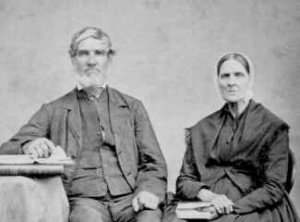New Mennonite Church of Canada West
The New Mennonite Church of Canada West resulted from a division in the Canada Conference (later known at the Mennonite Conference of Ontario) in 1849. Daniel Hoch (1805-1878) was silenced by Bishop Benjamin Eby on 27 May of that year, along with Bishop Jacob Gross and Deacon Jacob Albrecht, also among the ordained leaders at "The Twenty." They were silenced because of longstanding division within the congregation over the nature of evening prayer meetings, administration of a Sunday school and the nature of the conversion experience expected of persons being baptized into the church. The other ordained leaders at The Twenty, Dilman Moyer and Abraham Moyer (who were Daniel Hoch's step-brothers) favored more traditional Mennonite practice less influenced by renewal movements such as the Evangelical Association. They did not favor prayer meetings that included non-Mennonite church leaders, nor the emotional tone of these meetings that tried to bring seekers to a crisis conversion experience. They also wished Sunday schools to be administered only by ordained leaders, not by lay persons.
Bishop Jacob Gross soon left the Mennonite Church with a portion of the congregation and joined the Evangelical Association. Daniel Hoch, who was a devoted Mennonite even though he favored prayer meetings and crisis conversion experiences, had disagreed sharply with Gross's engagement with the Evangelical Association. Hoch sought reconciliation with the Canada Conference in Fall 1849. This attempt ended in failure. By 1850, if not earlier, Hoch was in contact with John H. Oberholtzer, who had led a division within the Franconia Conference in Pennsylvania in 1847. Oberholtzer and Hoch were very different in their priorities, but were both determined to remain within the Mennonite community.
By the end of 1850 Hoch and Jacob Albrecht had formulated a summary of church rules based on Oberholtzer's earlier work. Sympathetic persons from other parts of the Canada Conference joined Hoch and Albrecht in forming the new conference. In the fall of 1850 John Oberholtzer ordained Daniel Hoch as a bishop for the new group. Other minister who affiliated at least briefly with Hoch included Christian Troyer in the Markham area, Ulrich Geiger, John Bear, John B. Bauman, and Samuel Schlichter (who was ordained in 1852) in Waterloo region, and John Lapp in Clarence, New York. Bear and Geiger returned to the Canada Conference in 1851.
Hoch ordained four new ministers and a deacon by 1854, and the New Mennonites began to hold annual and semi-annual conference sessions following the Canada Conference pattern. In 1855 the New Mennonite churches in Canada West formed a joint conference with a Mennonite congregation in Wadsworth, Ohio led by Ephraim Hunsberger that also had a link to John Oberholtzer’s Pennsylvania group. This organization, known as the Mennonite Church of Canada West and Ohio, continued until at least 1871. There was a division within the New Mennonite Church in 1855 when several ministers withdrew because of their desire for a more "open" communion with other Protestant groups. The most prominent of those who departed was Abraham B. Sherk, who later became a well-known United Brethren minister.
When Oberholtzer's East Pennsylvania Conference suffered its own division that resulted in the formation of the Evangelical Mennonites led by William Gehman, the New Mennonites in Canada West worked hard to retain cordial relationships with both groups, and did so successfully throughout its existence. The New Mennonites participated in the formation of the new General Conference Mennonite Church, and Daniel Hoch chaired the 1861 General Conference sessions. The New Mennonites were also strong supporters of the Wadsworth Institute. Daniel Hoch's brother, Jacob, was on the board of the Institute until 1871.
In 1869 one final attempt was made at reconciliation between the Canada Conference and the New Mennonites. John Bear, who had briefly joined the New Mennonites in 1850, and Deacon Joseph Schneider drafted a proposal that was accepted by the Canada Conference. It would have recognized the ordinations of New Mennonite ministers and welcomed them into the Canada Conference. However Hoch's insistence that he had to be personally reconciled with Dilman Moyer, now bishop at "The Twenty," before the conference reconciliation could take place essentially doomed that effort.
In 1870 the New Mennonite Church of Canada West had 11 ministers and 12 places of meetings. It is estimated the New Mennonites had a population approaching 400.
In May 1874 another division in the Canada Conference (as well as the Indiana-Michigan Conference) resulted in the formation of the Reforming Mennonite Society led by Daniel Brenneman and Solomon Eby, with congregations in Ontario, Indiana and Michigan. In March 1875 the New Mennonite Church merged with the Reforming Mennonite Society to form the United Mennonite of Canada, Indiana and Michigan. After two further mergers, this body became the Mennonite Brethren in Christ in 1883. As late as 1872 the New Mennonite Church had sent a delegate to the General Conference Mennonite Church triennial sessions, but the new affiliation ended that relationship.
The merger with the Reforming Mennonite Society took this body in a new theological direction not contemplated or endorsed by Daniel Hoch, who died in isolation from the Mennonite community. Ironically his funeral sermon was preached by an Evangelical Association minister.
Bibliography
Huffman, Jasper A. History of the Mennonite Brethren in Christ Church. New Carlisle, O.: The Bethel Pub. Co, 1920.
Steiner, Samuel. "Assurance of Salvation or Faithful Living: Ontario Mennonites Disagree About Renewal." Unpublished paper, 2010.
Storms, Everek R. History of the United Missionary Church. Elkhart, Ind: Bethel Pub. Co, 1958.
| Author(s) | Sam Steiner |
|---|---|
| Date Published | February 2010 |
Cite This Article
MLA style
Steiner, Sam. "New Mennonite Church of Canada West." Global Anabaptist Mennonite Encyclopedia Online. February 2010. Web. 16 Apr 2024. https://gameo.org/index.php?title=New_Mennonite_Church_of_Canada_West&oldid=95948.
APA style
Steiner, Sam. (February 2010). New Mennonite Church of Canada West. Global Anabaptist Mennonite Encyclopedia Online. Retrieved 16 April 2024, from https://gameo.org/index.php?title=New_Mennonite_Church_of_Canada_West&oldid=95948.
©1996-2024 by the Global Anabaptist Mennonite Encyclopedia Online. All rights reserved.
